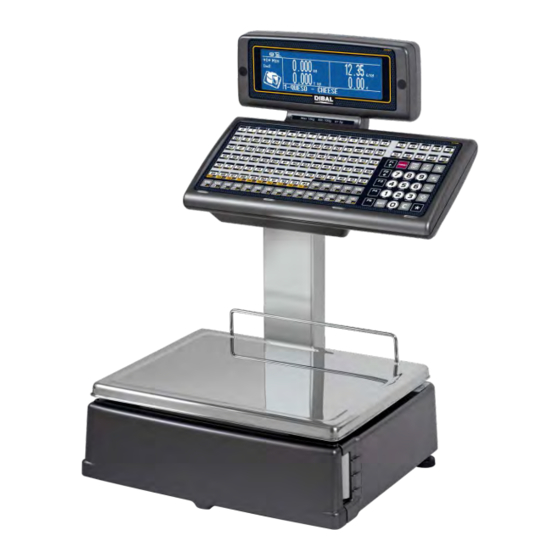Dibal 500 Series Grundlegendes Handbuch - Seite 7
Blättern Sie online oder laden Sie pdf Grundlegendes Handbuch für Skalen Dibal 500 Series herunter. Dibal 500 Series 17 Seiten.

Installation of scales
1.
Follow the instructions below to ensure correct installation and operation of the scales:
1)
Check that the mains voltage corresponds to that stated on the specifications label on the scales and
that it does not fluctuate in excess of 10% of nominal voltage.
2)
Make sure that the scales can be connected to a nearby socket that is easy to access. We
recommend that the socket should be provided with differential breaker, thermal-magnetic trips, and
ground.
3)
Make sure that other equipment such as refrigerators, cutting machines, etc. are not connected to
same socket.
4)
If the scales have a battery option, see Annex Battery operation.
5)
Only use the scales in areas that comply with the room temperature values stated on the specifications
label (-10ºC to 40ºC).
6)
Peripheral devices connected to the equipment must be protected against fluctuation peaks of
above 8A 100VA.
7)
The scales must be placed on a stable, level surface.
8)
No objects must come into contact with the dish.
9)
Avoid extreme temperatures. Do not place the scales in direct sunlight or close to air
conditioning vents.
10) These scales have not been designed as waterproof scales. Therefore, avoid high levels of
humidity since this might cause condensation. Protect from rain and avoid direct contact with
water. Do not spray water on the scales or submerge in water. If the scales get wet, switch off
the power supply immediately.
Switching on
2.
Check that the weighing scales are correctly installed and then turn on the switch on the bottom of the
scales.
While the scales are checked for any possible errors, the display shows a countdown from 9 to 0, and
information on the model, programme version and maximum range of the scales is shown.
When the countdown is complete, and no errors have been detected, articles and ingredients are
checked, and the display shows some dashes to indicate the scale range.
Menu structure
3.
•
Articles: articles programming.
•
Sales assistants: registration, removal and details of sales assistants.
•
Configuration: Programming of PC Configuration, keyboard, label, receipt, printing and EAN.
•
Texts: Programming of heading lines, publicity, sections, payment modes and traceability.
•
Communications: Programming of communications parameters and operations with PC.
•
Formats: Receipt and label formats programming.
•
Data: Programming of data, self-service mode, passwords and printing parameters.
•
Reports: list, logos y fonts.
•
Deletions: Deletion of data.
•
Macros: Macros programming.
1
